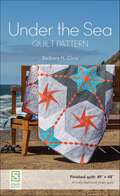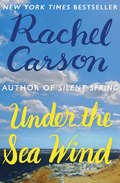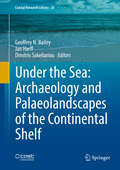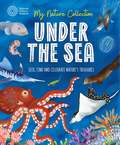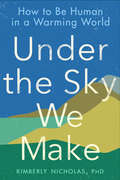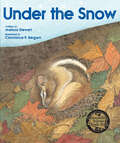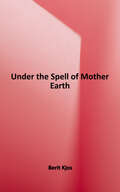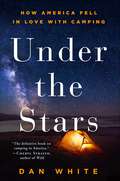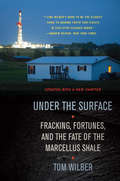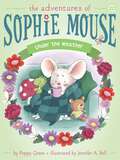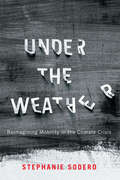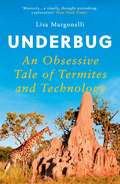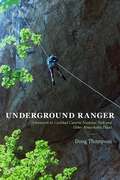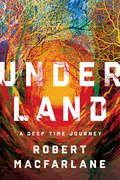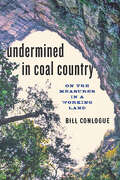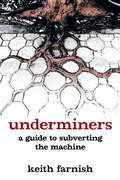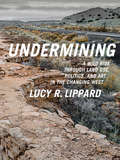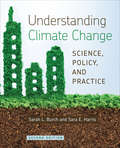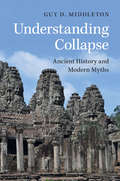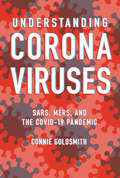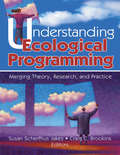- Table View
- List View
Under the Sea Quilt Pattern
by Barbara H. ClineStars, pinwheels, and diamonds. Oh my! Best-selling quilt designer Barbara Cline teaches you her fail-proof method for piecing diamond chains from strip sets. Alternate two triangle blocks in different colors to form attractive stars and pinwheels where the angles meet. Full-size template patterns and detailed instructions guide you in constructing this dynamic diamond-chain quilt. Learn how to piece diamond chains from strip sets 49" x 48" finished quilt with complete instructions and templates Wholesale minimum: 3 units.
Under the Sea Wind
by Rachel CarsonThis New York Times bestseller by the author of the environmental classic Silent Spring beautifully details the coastal ecosystem of birds and the sea. In her first book, preeminent nature writer Rachel Carson tells the story of the sea creatures and birds that dwell in and around the waters along North America&’s eastern coast—and the delicately balanced ecosystem that sustains them. Following the life cycles of a pair of sanderlings, a mackerel, and an eel, Carson gracefully weaves scientific observation with imaginative prose to educate and inspire, creating one of the finest wildlife narratives in American literature. This ebook features an illustrated biography of Rachel Carson including rare photos and never-before-seen documents from the Beinecke Rare Book and Manuscript Library at Yale University.
Under the Sea: Archaeology and Palaeolandscapes of the Continental Shelf
by Jan Harff Geoffrey N. Bailey Dimitris SakellariouThis book focuses on issues of method and interpretation in studies of submerged landscapes, concentrating on illustrations and case studies from around Europe with additional examples from other parts of the world. Such landscapes were once exposed as dry land during the low sea levels that prevailed during the glacial periods that occupied most of the past million years and provided extensive new territories for human exploitation. Their study today involves underwater investigation, using techniques and strategies which are clearly set out in these chapters. The underwater landscape provides a rich source of information about the archaeology of human settlement and long-term changes in environment, climate and sea-level. This book highlights how such information can be revealed and interpreted. The examples presented here and the focus on techniques make this book of worldwide relevance. Chapters describe examples of underwater archaeological investigation as well as collaboration with offshore industries and legal, management and training issues relating to underwater cultural heritage. Such studies point to the significance of this drowned landscape, and readers are invited to consider its human impact in terms of past settlement and population dispersal through palaeolandscape reconstruction and interpretation in relation to broader themes in human prehistory. This volume is based on work from COST Action SPLASHCOS, a four-year multi-disciplinary and multi-national research program supported by COST (European Cooperation in Science and Technology) and has something to benefit all those with an interest in the sea floor of the continental shelf and the archaeological and social impact of sea-level change, including archaeologists, marine scientists, geographers, cultural-heritage managers, commercial and governmental organisations, policy makers and interested members of the public.
Under the Sea: Seek, find and celebrate nature's treasures with the Natural History Museum (My Nature Collection)
by Cameron MenziesA stunning and interactive exploration of the natural world, celebrating the diversity of natural treasures under the sea and published in partnership with the Natural History Museum London.My Nature Collection: Under the Sea is filled with beautifully detailed artwork, highlighted natural treasures and hidden features to spot on every page. Deep-dive into many remarkable corners of the sea and get to know their special features, from hermit crabs in the harbour to iguanas in the Galápagos, from seahorses in the sea grasses to algae below Antarctica. Search and find each wonder in context, with answers and further explanations at the back of the book.My Nature Collection book series encourages readers age 7 and up to look carefully and consider Earth's natural habitats in detail through interactive questions and up-close artwork. The perfect collection of books for treasure collectors, fact hunters and all lovers of nature!Series titles include: In the Rainforest / Under the Ground / Under the Sea / Up in the Air
Under the Sky We Make: How to Be Human in a Warming World
by Kimberly NicholasIt's warming. It's us. We're sure. It's bad. But we can fix it.After speaking to the international public for close to fifteen years about sustainability, climate scientist Dr. Nicholas realized that concerned people were getting the wrong message about the climate crisis. Yes, companies and governments are hugely responsible for the mess we're in. But individuals CAN effect real, significant, and lasting change to solve this problem. Nicholas explores finding purpose in a warming world, combining her scientific expertise and her lived, personal experience in a way that seems fresh and deeply urgent: Agonizing over the climate costs of visiting loved ones overseas, how to find low-carbon love on Tinder, and even exploring her complicated family legacy involving supermarket turkeys.In her astonishing book Under the Sky We Make, Nicholas does for climate science what Michael Pollan did more than a decade ago for the food on our plate: offering a hopeful, clear-eyed, and somehow also hilarious guide to effecting real change, starting in our own lives. Saving ourselves from climate apocalypse will require radical shifts within each of us, to effect real change in our society and culture. But it can be done. It requires, Dr. Nicholas argues, belief in our own agency and value, alongside a deep understanding that no one will ever hand us power--we're going to have to seize it for ourselves.
Under the Snow
by Melissa StewartA cozy look at the amazing ways animals behave and interact with their environments on a snowy day.When snow falls, we go home where it is warm and safe. But what about all those animals out there in the forests and fields? What do they do when snow blankets the ground? Award-winning science writer Melissa Stewart offers a lyrical tour of a variety of habitats, providing young readers with vivid glimpses of animals as they live out the winter beneath the snow and ice. Constance R. Bergum's glowing watercolors perfectly capture the wonder and magic that can happen under the snow.
Under the Spell of Mother Earth
by Berit KjosThis book alerts readers to the signs of Goddess worship--even in America--and warns against elevating Mother Earth from legend to religion, basing environmental concerns in ancient pagan practices, depersonalizing God and people, and seeking a Goddess Mother as the source of life.
Under the Stars: How America Fell in Love with Camping
by Dan WhiteWide-ranging in research, enthusiasm, and geography, Dan White's Under the Stars reveals a vast population of nature seekers, a country still in love with its wild places. “The definitive book on camping in America. . . . A passionate, witty, and deeply engaging examination of why humans venture into the wild.”—Cheryl Strayed, author of WildFrom the Sierras to the Adirondacks and the Everglades, Dan White travels the nation to experience firsthand—and sometimes face first—how the American wilderness transformed from the devil’s playground into a source of adventure, relaxation, and renewal.Whether he’s camping nude in cougar country, being attacked by wildlife while “glamping,” or crashing a girls-only adventure for urban teens, Dan White seeks to animate the evolution of outdoor recreation. In the process, he demonstrates how the likes of Emerson, Thoreau, Roosevelt, and Muir—along with visionaries such as Adirondack Murray, Horace Kephart, and Juliette Gordon Low—helped blaze a trail from Transcendentalism to Leave No Trace.
Under the Surface: Fracking, Fortunes, and the Fate of the Marcellus Shale, Updated Edition
by Tom WilberRunning from southern West Virginia through eastern Ohio, across central and northeast Pennsylvania, and into New York through the Southern Tier and the Catskills, the Marcellus Shale formation underlies a sparsely populated region that features striking landscapes, critical watersheds, and a struggling economic base. It also contains one of the world's largest supplies of natural gas, a resource that has been dismissed as inaccessible—until recently. Technological developments that combine horizontal drilling with hydraulic fracturing ("fracking") have removed physical and economic barriers to extracting hundreds of trillions of cubic feet of gas from bedrock deep below the Appalachian basin. Beginning in 2006, the first successful Marcellus gas wells by Range Resources, combined with a spike in the value of natural gas, spurred a modern-day gold rush—a "gas rush"—with profound ramifications for environmental policy, energy markets, political dynamics, and the lives of the people living in the Marcellus region. Under the Surface is the first book-length journalistic overview of shale gas development and the controversies surrounding it. Control over drilling rights is at stake in the heart of Marcellus country—northeast Pennsylvania and central New York. The decisions by landowners to work with or against the companies—and the resulting environmental and economic consequences—are scrutinized by neighbors faced with similar decisions, by residents of cities whose water supply originates in the exploration area, and by those living across state lines with differing attitudes and policies concerning extraction industries. Wilber's evenhanded treatment gives a voice to all constituencies, including farmers and landowners tempted by the prospects of wealth but wary of the consequences, policymakers struggling with divisive issues, and activists coordinating campaigns based on their respective visions of economic salvation and environmental ruin. Wilber describes a landscape in which the battle over the Marcellus ranges from the very local—yard signs proclaiming landowners' allegiances for or against shale gas development—to often conflicting municipal, state, and federal legislation intended to accelerate, delay, or discourage exploration. For millions of people with a direct stake in shale gas exploration in the Marcellus or any number of other emerging shale resources in the United States and worldwide, or for those concerned about the global energy outlook, Under the Surface offers a worthwhile and engaging look at the issues.
Under the Weather (The Adventures of Sophie Mouse #20)
by Poppy GreenSophie is jealous of the attention her brother gets from their parents while he&’s sick in this twentieth book of The Adventures of Sophie Mouse!When Sophie&’s brother, Winston, gets sick, Sophie feels bad for him…at first. But when she sees how much attention he&’s getting from their parents, she starts to feel something else: jealousy. Sophie normally loves school, but now she wishes she could stay home and play all day like Winston. But when Sophie begins to get the sniffles herself, she realizes she was much better off without them. With easy-to-read language and illustrations on almost every page, the Sophie Mouse chapter books are perfect for beginning readers!
Under the Weather: Reimagining Mobility in the Climate Crisis (McGill-Queen's/Brian Mulroney Institute of Government Studies in Leadership, Public Policy, and Governance)
by Stephanie SoderoHumans and human mobility, including driving and flying, are entangled with the climate emergency. Fossil-fuelled mobility worsens severe weather, and in turn, severe weather disrupts human mobility. A shift to zero-emission vehicles is critical but insufficient to repair the damage or prepare communities for the coming disruptions severe weather will bring. In Under the Weather Stephanie Sodero explores the intersection between human mobility and severe weather. Anchored in two Atlantic Canadian hurricane case studies, Hurricane Juan in Mi'kma'ki/Nova Scotia in 2003 and Hurricane Igor in Ktaqmkuk/Newfoundland in 2010, the book contributes to contemporary cultural and policy discussions by offering five practical recommendations – revolutionize mobility, prioritize vital mobility of medical goods and services, embrace ecological mobilities, rebrand redundancy, and think flexibly – for how mobility can be reimagined to work with, rather than against, the climate in ways that also benefit the health, education, and economy of local communities. This ecological approach to mobilities sheds light on extreme mobility dependency and the impact of mobility disruptions on the ground in Canadian communities.Focusing on the entangled relationship between human mobility and the climate, Under the Weather examines how communities can transform their relationship with mobility to enable greater resilience.
Under the Weather: Stories about Climate Change
by Tony BradmanFrom the effects of rising sea levels to changes in animal behaviour and human lifestyles, these powerful stories portray the issues surrounding climate change in personal terms and so bring them vividly to life. Offering warnings and inspiration in equal measure, the stories cover a wide range of localities from Siberia and Canada to Australia, UK, Sri Lanka, and the Philippines. Writers include award-winning Linda Newbery as well as exciting newcomers like Australia's George Ivanoff. Whether read from cover to cover or dipped into for one or two stories, this book will enlighten and inspire everyone to consider how climate change will affect us all.
Underbug: An Obsessive Tale of Termites and Technology
by Lisa MargonelliWho has the answer to the world&’s fuel problems? How can we bring ruined land back to life? Where do roboticists turn when they try to engineer a hive mind? Termites. Strange though it may seem, scientists are looking to these much-reviled insects as little guides to the biggest of ideas. Lisa Margonelli follows them to find out how termites could change the world. A masterpiece of popular science, Underbug touches on everything from metaphysical meditation, technological innovation and the psychology of obsession to good old-fashioned biology.
Underground Ranger: Adventures in Carlsbad Caverns National Park and Other Remarkable Places
by Doug ThompsonFor six exciting years Doug Thompson worked as a park ranger at Carlsbad Caverns National Park. In Underground Ranger he passes along the essence of what he learned on this unusual job and in his related adventures exploring the surrounding Chihuahuan Desert. He overcame his fear of tight spaces and heights, learned to climb rope, and went on to explore many of the deep vertical caves in the Guadalupe Mountains of western Texas and southeastern New Mexico—including Lechuguilla Cave, one of the most spectacular underground wonders of the world. He even became a member of the park&’s technical rescue team and made a fifty-story rappel into one of the deepest underground pits in the United States. In visceral detail, Thompson shares the physical and mythical stories of caves and shows what it&’s like to experience the extravagant beauty of nature&’s underground realm.
Underland: A Deep Time Journey
by Robert MacfarlaneFrom the best-selling, award-winning author of Landmarks and The Old Ways, a haunting voyage into the planet’s past and future. Hailed as "the great nature writer of this generation" (Wall Street Journal), Robert Macfarlane is the celebrated author of books about the intersections of the human and the natural realms. In Underland, he delivers his masterpiece: an epic exploration of the Earth’s underworlds as they exist in myth, literature, memory, and the land itself. In this highly anticipated sequel to his international bestseller The Old Ways, Macfarlane takes us on an extraordinary journey into our relationship with darkness, burial, and what lies beneath the surface of both place and mind. Traveling through “deep time”—the dizzying expanses of geologic time that stretch away from the present—he moves from the birth of the universe to a post-human future, from the prehistoric art of Norwegian sea caves to the blue depths of the Greenland ice cap, from Bronze Age funeral chambers to the catacomb labyrinth below Paris, and from the underground fungal networks through which trees communicate to a deep-sunk “hiding place” where nuclear waste will be stored for 100,000 years to come. “Woven through Macfarlane’s own travels are the unforgettable stories of descents into the underland made across history by explorers, artists, cavers, divers, mourners, dreamers, and murderers, all of whom have been drawn for different reasons to seek what Cormac McCarthy calls “the awful darkness within the world.” Global in its geography and written with great lyricism and power, Underland speaks powerfully to our present moment. Taking a deep-time view of our planet, Macfarlane here asks a vital and unsettling question: “Are we being good ancestors to the future Earth?” Underland marks a new turn in Macfarlane’s long-term mapping of the relations of landscape and the human heart. From its remarkable opening pages to its deeply moving conclusion, it is a journey into wonder, loss, fear, and hope. At once ancient and urgent, this is a book that will change the way you see the world.
Undermined in Coal Country: On the Measures in a Working Land
by Bill ConlogueA study of lives and landscapes in Pennsylvania’s Lackawanna Valley and “what the region’s history of mining reveals about human folly and endeavor” (The Chronicle of Higher Education).Deep mining ended decades ago in Pennsylvania’s Lackawanna Valley. The barons who made their fortunes have moved on. Low wages and high unemployment haunt the area, and the people left behind wonder whether to stay or seek their fortunes elsewhere.Bill Conlogue explores how two overlapping coal country landscapes—Scranton, Pennsylvania, and Marywood University—have coped with the devastating aftermath of mining. Examining the far-reaching environmental effects of mining, this beautifully written book asks bigger questions about what it means to influence a landscape to this extent—and then to live in it. In prose rivaling that of Annie Dillard and John McPhee, Conlogue argues that, if we are serious about solving environmental problems, if we are serious about knowing where we are and what happens there, we need to attend closely to all places—that is, to attend to the world in a cold, dark, and disorienting universe. Unearthing new ways of thinking about place, pedagogy, and the environment, this meditative text reveals that place is inherently unstable.
Underminers
by Keith FarnishA vibrant, growing movement of radical protest is sweeping North America in opposition to high-stakes capitalism and the appalling environmental desecration that accompanies it. <P><P>At once entertaining, shocking and inspiring, Underminers is the monkey-wrencher's guide to navigating and subverting the industrial machine, showing how symbolic protestors can become real activists; reconnected to one another, and co-creators of a viable future.
Undermining: A Wild Ride Through Land Use, Politics, and Art in the Changing West
by Lucy R. Lippard&“A marvelous slim book [that] weaves . . . ideas, facts, images, and histories into a whole about . . . the ecology of the manmade world.&” —Rebecca Solnit In Undermining, the award-winning author, art historian and social critic Lucy R. Lippard delivers &“another trademark work&” that combines text and full-color images to explore &“the intersection of art, the environment, geography and politics&” (Kirkus Reviews). Working from her own experience of life in a New Mexico village, and inspired by the gravel pits in the surrounding landscape, Lippard addresses a number of fascinating themes—including fracking, mining, land art, adobe buildings, ruins, Indian land rights, the Old West, tourism, photography, and water. In her meditations, she illuminates the relationship between culture, industry, and the land. From threatened Native American sacred sites to the history of uranium mining, she offers a skeptical examination of the &“subterranean economy.&” Featuring more than two hundred gorgeous color images, Undermining offers a provocative new perspective on the relationship between art and place in a rapidly shifting society. &“[Lippard&’s] strength lies in the depth of [her] commitment—her dual loyalty to tradition and modernity and her effort to restore the broken connection between the two.&” —Suzi Gablik, The New York Times Book Review
Understanding Built Environment
by Fumihiko Seta Arindam Biswas Ajay Khare Joy SenThis book is a comprehensive document visualizing the future of built environment from a multidisciplinary dimension, with special emphasis on the Indian scenario. The multidisciplinary focus would be helpful for the readers to cross-refer and understand others' perspectives. The text also includes case studies substantiating theoretical research. This method of composition helps the book to maintain rational balance among theory, research and its contextual application. The book comprises selected papers from the National Conference on Sustainable Built Environment. The chapters provide varied viewpoints on the core issues of urbanization and planning. This compilation would be of interest to students, researchers, professionals and policy makers.
Understanding Climate Change
by Sarah Burch Sara HarrisConversations about climate change are filled with challenges involving complex data, deeply held values, and political issues. Understanding Climate Change provides readers with a concise, accessible, and holistic picture of the climate change problem, including both the scientific and human dimensions.Understanding Climate Change examines climate change as both a scientific and a public policy issue. Sarah L. Burch and Sara E. Harris explain the basics of the climate system, climate models and prediction, and human and biophysical impacts, as well as strategies for reducing greenhouse gas emissions, enhancing adaptability, and enabling climate change governance. The authors examine the connections between climate change and other pressing issues, such as human health, poverty, and other environmental problems, and they explore the ways that sustainable responses to climate change can simultaneously address those issues.An effective and integrated introduction to an urgent and controversial issue, Understanding Climate Change contains the tools needed for students, instructors, and decision-makers to become constructive participants in the human response to climate change.
Understanding Climate Change through Religious Lifeworlds
by David L. HabermanHow can religion help to understand and contend with the challenges of climate change?Understanding Climate Change through Religious Lifeworld,edited by David Haberman, presents a unique collection of essays that detail how the effects of human-related climate change are actively reshaping religious ideas and practices, even as religious groups and communities endeavor to bring their traditions to bear on mounting climate challenges.People of faith from the low-lying islands of the South Pacific to the glacial regions of the Himalayas are influencing how their communities understand earthly problems and develop meaningful responses to them. This collection focuses on a variety of different aspects of this critical interaction, including the role of religion in ongoing debates about climate change, religious sources of environmental knowledge and how this knowledge informs community responses to climate change, and the ways that climate change is in turn driving religious change.Understanding Climate Change through Religious Lifeworlds offers a transnational view of how religion reconciles the concepts of the global and the local and influences the challenges of climate change.
Understanding Climate Change: Science, Policy, and Practice, Second Edition
by Sarah Burch Sara E. HarrisConversations about climate change are filled with challenges involving complex data, deeply held values, and political issues. Understanding Climate Change examines climate change as both a scientific and a public policy issue. Sarah L. Burch and Sara E. Harris explain the basics of the climate system, climate models and prediction, and human and biophysical impacts, as well as strategies for climate change adaptation and mitigation. The second edition has been fully updated throughout, including coverage of new advances in climate modelling and of the shifting landscape of renewable energy production and distribution. A brand new chapter discusses global governance, including the United Nations Framework Convention on Climate Change and the Paris Agreement, as well as mitigation efforts at the national and subnational levels. This new chapter makes the book even more relevant to climate change courses housed in social sciences departments such as political science and geography. An effective and integrated introduction to an urgent and controversial issue, this book is well-suited to adoption in a variety of introductory climate change courses found in a number of science and social science departments. Its ultimate goal is to equip readers with the tools needed to become constructive participants in the human response to climate change.
Understanding Collapse: Ancient History and Modern Myths
by Guy D. MiddletonUnderstanding Collapse explores the collapse of ancient civilisations, such as the Roman Empire, the Maya, and Easter Island. In this lively survey, Guy D. Middleton critically examines our ideas about collapse - how we explain it and how we have constructed potentially misleading myths around collapses - showing how and why collapse of societies was a much more complex phenomenon than is often admitted. Rather than positing a single explanatory model of collapse - economic, social, or environmental - Middleton gives full consideration to the overlooked resilience in communities of ancient peoples and the choices that they made. He offers a fresh interpretation of collapse that will be accessible to both students and scholars. The book is an engaging, introductory-level survey of collapse in the archaeology/history literature, which will be ideal for use in courses on the collapse of civilizations, sustainability, and climate change. It includes up-to-date case studies of famous and less well-known examples of collapses, and is illustrated with 25 black and white illustrations, 3 line drawings, 16 tables and 18 maps.
Understanding Coronaviruses: SARS, MERS, and the COVID-19 Pandemic
by Connie GoldsmithWhile many scientists believed influenza would cause the next great pandemic, no one was prepared for the new strain of coronavirus that appeared in 2019. SARS-CoV-2, the virus that causes COVID-19, has infiltrated every country and put global public health and the economy at risk. Health-care systems have been pushed to the limit as protective gear, life-saving equipment, tests, and vaccines are scarce and in high demand. From the initial infection to the widespread impact on daily life, Understanding Coronaviruses examines the intricacies of SARS-CoV-2 and COVID-19 and how they compare to previous viruses and pandemics.
Understanding Ecological Programming: Merging Theory, Research, and Practice
by Susan Scherffiu Jakes Craig BrookinsIncrease the effectiveness of prevention programs by altering community and social settings! Understanding Ecological Programming: Merging Theory, Research, and Practice contains vital information to help you become a better community-based program designer using ecological programming. Focused on the basic concept of the ecological progra
